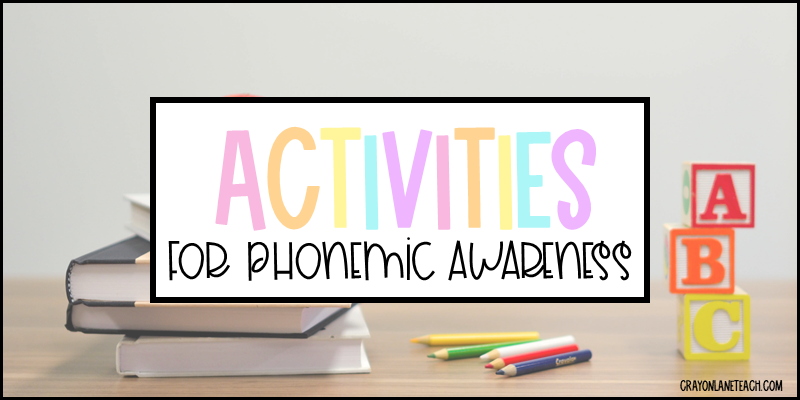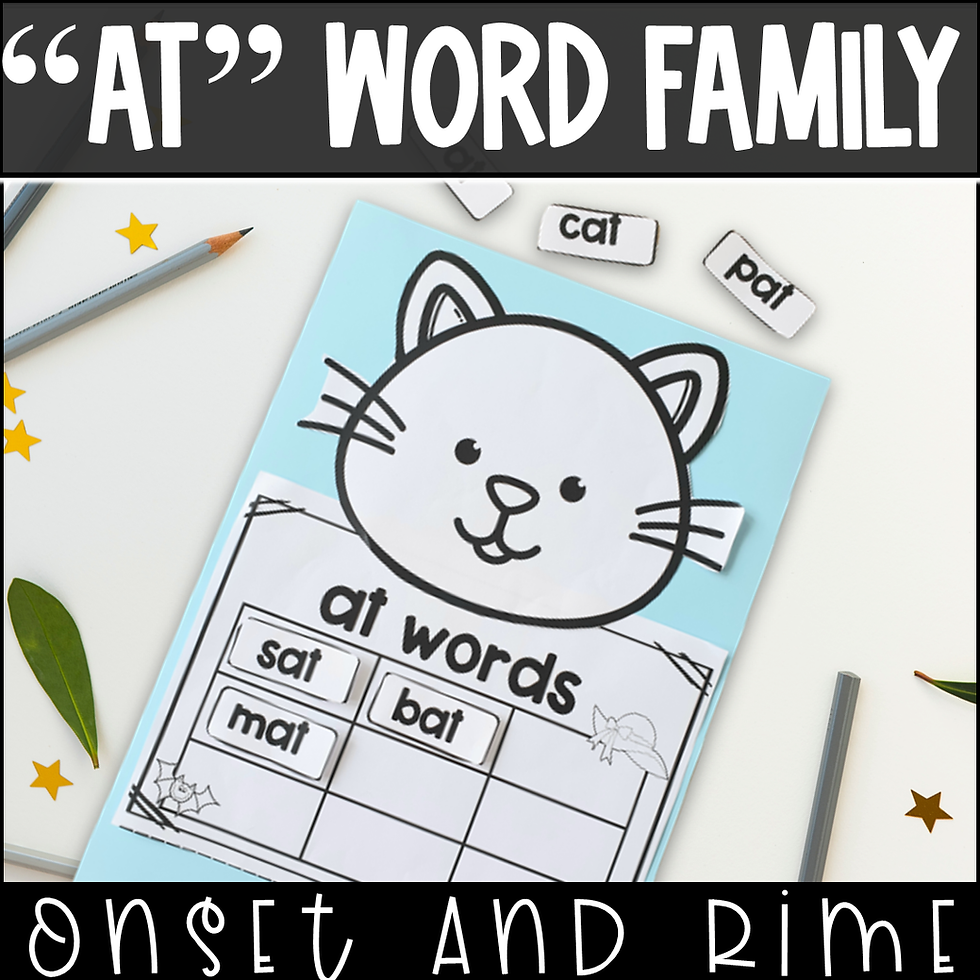Activities for Phonemic Awareness
- gmmcooney
- Feb 21, 2022
- 7 min read
Updated: Mar 15, 2025

Today we are going to be looking at different activities for phonemic awareness. By exploring phonemic awareness with your students through fun activities you will be helping them develop the basis for learning how to read. Having a good understanding of phonemic and phonological awareness is ideal before moving on to learning phonics.
Do you want some free Literacy/ELA resources? Sign up here to receive a free phonological awareness pack, perfect for assessing your student’s phonological awareness through lots of fun activities. After signing up, you will be the first to learn about my new teaching resources, teacher tips and blog posts making sure you always have fun teaching ideas all year round! Click here to sign up!
In this blog post we are going to look at what phonemic awareness is, as well as the main differences between phonics and phonemic awareness. We are also going to explore the 7 essential phonemic awareness skills as well as a range of engaging activities for teaching phonemic awareness.
If you would prefer to see step by step how I use activities for teaching phonemic awareness, you can watch the video below!
What is Phonemic Awareness and why is it important?
Phonemic awareness is when your children can focus on and manipulate phonemes (individual sounds) in spoken words. Phonemic awareness is when children have awareness of phonemes (individual sounds) in words and can hear them. It is important as it develops your child’s awareness that words are made up of individual sounds. Once your students have a good understanding of this, they are now ready to learn phonics and how to read.
What is the difference between phonics and phonemic awareness?
When teaching younger children, you may be hearing the words phonemic awareness and phonics and be wondering what the differences are between these terms? Phonemic awareness is an awareness of individual sounds in spoken words. Phonics is connecting written letters to sounds in words. The main difference between phonics and phonemic awareness is phonics involves the image or visual of the letter shape and phonemic awareness can be explored more verbally. Phonics is about transferring the spoken sounds to writing.
What are the 7 essential phonemic awareness skills?
Let’s have a quick overview of the 7 essential skills before moving onto looking at activities for phonemic awareness.
Phonological awareness – encompasses a range of skills
Isolation – recognise individual sounds
Blending sounds
Segmentation – break words up into sounds they can hear
Deletion – removing sounds to make new words
Addition – adding new sounds to make new words
Substitution – changing sounds to make new words
How is Phonemic Awareness Taught?
Activities for Phonemic Awareness
Phonological awareness
Phonological awareness encompasses a range of skills and includes things such as syllables, alliteration and onset and rime.
If you would like to learn some more about phonological awareness, make sure to read my blog post: Ready to Read? How to know when your kids are ready to read. You can also download my free phonological awareness pack, to help you determine if your students are ready to learn how to read.
Activity Ideas
Counting syllables - you can do this by counting how many claps are in a word. A fun way to introduce this is to ask children to clap out the syllables in their name. Make sure to check out my Counting Syllables worksheets to give your students more practise at this skills.
Onset & rime, rhyming words – ask for words that rhyme with… , explore nursery rhymes or books with rhyming words. You can also use some fun activities that explore onset and rhyme and word families.
Initial and end sounds – give children a word and ask them to identify the beginning or end sound. Your kids can get lots of practise at identifying initial and end sounds with my beginning, middle and ending sounds resource pack.
Alliteration – You can give children a selection of cards with pictures on them and ask them to match the words that begin with the same sound.
If you would like to learn more about phonological awareness and get some more activity ideas, check out my blog post: Ready to Read?
Sound Isolation
Sound isolation is where your children can identify initial, middle and end sounds in words.
Activity Ideas
An easy but fun way to develop this skill is to play I spy and ask your students to find something beginning with…, or ends with… This game can also be done with middle sounds too!
Another activity could be spreading out cards with pictures of objects on them. You could choose a card and ask your students what sound that object begins with. You could take this a step further if your children are beginning to explore phonics and instead of pictures being on the cards you could have CVC words. You could also do this activity another way and ask children to find you a word beginning with… Then your student picks a picture beginning with the correct sound.
When your students are beginning to explore phonics, they can start to work on written activities such as my beginning sounds worksheets, where they need to identify the correct beginning sound in a word.
Children can also find the correct middle sound with my Short Vowels Find the Missing Middle Sound activity.
Blending
Blending is where children blend individual sounds together to make words. This can be done verbally at first by saying individual sounds to your students and modelling how to blend them together. You can always start off with two sounds at first and model how to blend these together before moving onto CVC words.
Activity Ideas
First of all, you can ask your children to repeat two sounds after you. Then you can practise together stretching these sounds out and then blending them verbally. Once your children have grown confident with this you can do this activity using CVC words. This CVC Word activity is great for practising blending sounds together as your students can read and draw the CVC words.
Another activity you could do that explores CVC words is a game I call Splat! Lay a selection of cards with CVC words on a surface and give your children a plastic fly swatter. Then ask your children to splat a certain word.
Exploring CVC words through onset and rime is another great way to develop your student’s ability to blend sounds together. Learning word families allows your children to use their knowledge of rhyme to help with blending and word recognition. You can use some fun onset and rhyme activities to help your students develop these skills.
Segmentation
Segmentation is where you count the number of sounds in a word. This skill can also be done with sentences where children count the number of words in a sentence.
Activity Ideas
The first activity you can do is ask your student to say a word. It would be a good idea to start off with a CVC word. Then ask your student to count how many sounds they can hear in the word. Your student can lay a counter down to represent each sound they hear. This can be taken a step further by showing your student a CVC word card and asking them to say and lay down a counter for each sound in that word.
If your children are ready to move onto segmenting sentences you can ask your students to count how many words in a sentence. Your students can use counters in the same way as I mentioned above when segmenting words.
An active way to explore segmenting words and sentences is to use hula hoops! Your children can jump to show each sound or word they hear.
Sound Deletion
Sound deletion is where we take a sound away and make a new word.
Activity Ideas
A simple activity to develop this skill would be to compare two words such as “trip” and “tip” and ask your children if they can hear what sound is missing?
You could then do the reverse of this and give your children a word such as “trip”. Then say, take away the “r”, what is our new word?
Sound Addition
Sound addition is where we add a sound to make a new word.
Activity Ideas
An easy way to practise this skill would be to give your children a word such a “cat”. Then give your children a second word such as “cart”, then ask what new sound has been added to the word.
You could then do the opposite and give your child the word “cat”, then say add the sound “r” before the “t”. What is our new word? Remember when adding sounds, you will need to tell your students where in the word to add them.
Sound Substitution
Sound substitution is where we change a sound in a word for a different sound.
Activity Ideas
Magnetic letters are a great resource for developing this skill. Ask your children to make a word such as “cat”. Then ask them to substitute the beginning sound for other beginning sounds to make new words. You can discuss if the words they make are real words or nonsense words.
Looking at onset and rime will also help your students develop this skill. Your children can create CVC Word Flip Books like the kind below to explore word families and practise substituting initial sounds in CVC words.














Comments